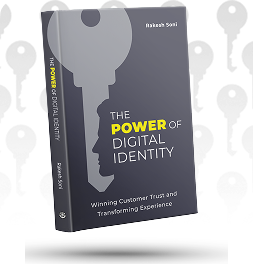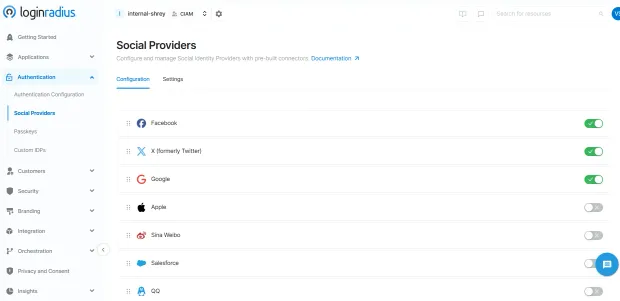WordPress Social Login: Simplify Sign-Ups in One Click
Discover how to add social login to your WordPress site—no coding required. This guide covers the top plugins, simple setup steps, and the real reasons to make the switch. Learn how social login can boost user engagement, streamline sign-ups, and improve conversions, turning your WordPress site into a smarter, more user-friendly platform.


Learn How to Master Digital Trust

The State of Consumer Digital ID 2024

Top CIAM Platform 2024
Introduction
Ever tried logging into a website and felt instantly annoyed by the need to “create an account,” confirm your email, set a password (that meets six complex rules), and then finally... you're in? Now imagine your users going through that same frustrating ritual on your WordPress site, only to abandon it halfway.
Here’s the truth: users today expect simplicity. They want to get in, interact, and move on without the friction of traditional login forms. And that’s exactly where WordPress social login shines.
By enabling users to log in with their existing social media accounts like Google, Facebook, LinkedIn, or X, you offer them a familiar and seamless way to access your site. No extra passwords to remember. No forms to fill. Just one click, and they’re in. It’s fast, secure, and it dramatically improves user experience, especially on mobile, where typing passwords is even more painful.
From a site owner’s perspective, it’s a win-win. Social login can reduce drop-offs on your registration page, increase sign-ups, and even give you access to verified email addresses and user profile data. Whether you're running a blog, a membership site, or a full-fledged WooCommerce store, integrating a WordPress social plugin is one of the smartest ways to remove login barriers.
In this blog, we’ll break down exactly how to add social login in WordPress without any coding headaches. We’ll walk you through the best plugins available, how to set them up, and why it’s worth making the switch. You’ll also learn the benefits of social login from a user engagement and conversion perspective, so you’re not just adding a shiny feature you’re making your WordPress site smarter.
So if you’re ready to offer your users a frictionless way to log in with social media on WordPress, you’re in the right place. Let’s get started.
What is a Social Media Login?
Think about the last time you signed up for a new website. Chances are, you were relieved to see a “Continue with Google” or “Log in with Facebook” button. That’s social media login in action also called social login or social sign-in.
At its core, social login is a simple way for users to log into a website using their existing social media credentials like Google, Facebook, Apple, LinkedIn, GitHub, or others. Instead of creating a brand-new account with a username and password, users grant permission for the site to access basic profile information from their social media account (usually just name and email).
![]()
This is made possible through OAuth, the secure authorization protocol behind most WordPress social login systems. Don’t worry you don’t need to understand the inner workings of OAuth to use it. Most WordPress social plugins handle this behind the scenes for you.
From the user’s perspective, social login feels magical:
-
No passwords to remember
-
One-click login across devices
-
Less friction during checkout or sign-up
From your perspective as a WordPress site owner, it means:
-
More registrations with fewer abandoned forms
-
Better quality user data (real emails, real profiles)
-
A modern, mobile-friendly experience that improves trust and usability
Whether you're building a blog, a subscription site, or an eCommerce platform, login with social media WordPress functionality is no longer just a “nice-to-have.” It’s expected.
Which Plugins Can Be Used to Add Social Login to WordPress?
When it comes to adding social login to WordPress, there’s no shortage of plugins in the market. But not all are created equal. Some offer basic functionality, while others deliver enterprise-level scalability, better branding, and more control over the user experience.
Here’s a look at some of the most trusted and widely used WordPress social plugins, including their core features and who they’re best suited for.
1. LoginRadius WordPress Social Plugin
The LoginRadius WordPress Social Plugin is best for: Businesses that need secure, scalable, and branded social login.
-
Supports 40+ social platforms, including Google, Facebook, Apple, LinkedIn, and more.
-
Built-in privacy and compliance support (GDPR, CCPA).
-
Offers advanced identity features like progressive profiling and adaptive login.
-
Easily integrates with WooCommerce, membership sites, and marketing tools.
-
Developer-friendly, API-first architecture.
Why it's different: Unlike most plugins, LoginRadius is a full CIAM (Customer Identity and Access Management) platform. If you care about data security, seamless integration, and enterprise-grade identity, this is a future-proof choice.
Read the complete developer documents here.
2. Nextend Social Login
Best for: Bloggers and small sites looking for easy, free setup.
-
Supports Google, Facebook, and Twitter (free version).
-
Pro version adds LinkedIn, Amazon, and more.
-
Integrates with WooCommerce and BuddyPress.
-
Custom redirect URLs, login button customization.
3. Super Socializer
Best for: Sites that want social login + sharing in one.
-
Social login, social sharing, and comments bundled together.
-
100+ social network options.
-
WooCommerce and BuddyPress compatible.
-
GDPR compliance tools included.
4. WP Social Login (by miniOrange)
Best for: Mid-size businesses wanting feature-rich flexibility.
-
Multiple social providers + SSO support.
-
Role mapping, custom redirection, and email sync.
-
Integration with LearnDash, WooCommerce, and others.
-
Custom app setup support.
5. Heateor Social Login
Best for: Simplicity and clean design.
-
Google, Facebook, and Twitter login options.
-
Lightweight and responsive UI.
-
Button placement on login, register, and comment forms.
-
Includes basic GDPR compliance features.
Plugin Comparison Table: Top WordPress Social Login Plugins
| Plugin | ## of Providers | Custom Branding | GDPR Ready | Best For |
|---|---|---|---|---|
| LoginRadius | 40+ | ✅ Full Control | ✅ Yes | Scalable businesses and CIAM use cases |
| Nextend Social Login | 3 (Free), 8+ Pro | 🔶 Limited (Pro) | ❌ No | Blogs and small eCommerce sites |
| Super Socializer | 100+ | 🔶 Basic (CSS) | ✅ Manual | All-in-one login + sharing setup |
| WP Social Login | 10+ (Pro) | 🔶 Moderate | ✅ Partial | Education portals, WordPress multisites |
| Heateor Social Login | 3–5 | 🔶 Minimal | ✅ Basic | Lightweight login for simple sites |
Choosing the right WP social plugin really depends on your goals do you want a quick fix, or a robust, scalable login experience that grows with your business?
Pro Tip:
If your business is privacy-focused, requires enterprise-level identity security, or needs deep integration across products, LoginRadius stands out as a complete WordPress social plugin solution—not just a front-end utility.
How to Add Social Login Plugin to WordPress Website
Adding a WordPress social login to your site might sound technical—but with the right plugin, it's actually very beginner-friendly. Whether you're a blogger, store owner, or developer, you can set this up without writing a single line of code.
Here’s a step-by-step guide to help you add social login in WordPress using a plugin like LoginRadius or Nextend.
Step 1: Choose the Right Plugin
If you want a fully customizable, scalable, and secure solution, LoginRadius is a strong option. If you just need basic functionality for a small blog, others like Nextend work well.
Step 2: Install and Activate the Plugin
-
Go to your WordPress Admin Dashboard
-
Navigate to Plugins → Add New
-
Search for your chosen plugin (e.g., “LoginRadius”)
-
Click Install Now
-
Then click Activate
You’ll now see the plugin menu appear in your WordPress sidebar.
Step 3: Configure Social Providers
To enable login options like “Login with Google” or “Continue with Facebook,” you need to connect your site to each provider:
-
Google: Go to Google Cloud Console, create a project, and enable OAuth credentials
-
Facebook: Visit Meta for Developers, create an app, and generate an App ID + Secret
-
LinkedIn, Apple, or others follow similar steps
Don’t worry; most plugins provide detailed setup guides and callback URLs. Just copy-paste the client ID and secret into the plugin settings.
Here’s how easy it is to select the social provider in the LoginRadius Admin Console:

Step 4: Customize the UI and Placement
-
Choose where you want the social login buttons to appear:
- On the login page
- Registration form
- Checkout page (for WooCommerce)
- Blog comment forms
-
Customize button style, text (“Login with Google”), and alignment to match your brand.
With LoginRadius, you can go a step further and fully match the look and feel of your site—even on hosted login pages.
Step 5: Test the Social Login Flow
Once configured, open a new incognito browser and go to your login page. Try signing in using your connected social provider.
Check that:
-
The button redirects to the provider login screen
-
You’re prompted for permissions
-
You’re redirected back to your site and logged in
-
A user profile is created in WordPress
If everything flows smoothly, you’ve successfully added login with social media WordPress functionality to your site!
Step 6: Optional Advanced Settings
-
Enable role mapping (e.g., Facebook users = subscribers)
-
Add redirect URLs (e.g., after login, go to dashboard)
-
Enable email verification (especially useful for gated content)
-
Integrate with WooCommerce for frictionless checkout
Adding a WordPress social plugin isn't just a backend tweak; it’s a front-door upgrade to your user experience. By letting users sign in with accounts they already trust, you’re removing unnecessary steps, building trust, and setting yourself apart from sites still stuck in the old username-and-password world.
Why Add Social Media Login to WordPress?
If you’ve ever abandoned a website just because it asked you to “create an account,” you're not alone, and neither are your users. The average person has over 100 online accounts, and password fatigue is very real. When faced with yet another registration form, most users don’t think twice before bouncing.
Now imagine giving those same users a shortcut something familiar, frictionless, and secure. That’s exactly what WordPress social login delivers.
With login with social media WordPress functionality, you empower users to sign up or sign in using accounts they already trust—like Google, Facebook, LinkedIn, or even Apple. And that one simple change unlocks a host of benefits, both for your users and for you as a WordPress site owner.
Here’s why it matters:
1. Reduce Sign-Up Friction, Boost Conversions
Online attention spans are short. Every extra field in your registration form increases the chance of a user dropping off. But when visitors can log in with a single click using their social media credentials, you drastically reduce that barrier to entry.
For WordPress sites, especially ones focused on subscriptions, communities, or gated content, WordPress login with social media can improve registration rates by up to 30–50% (based on industry data). That’s a massive gain for such a lightweight change.
2. Create a Seamless Mobile Experience
Let’s be real, typing complex passwords on mobile devices is a UX nightmare. Autocorrect kicks in, typos happen, and people give up.
By enabling WordPress social login, you provide a tap-and-go experience that’s made for mobile. Google, Facebook, and Apple all offer native login flows that autofill credentials securely, making the process almost invisible to the user.
3. Collect Verified and Enriched User Data
When users sign up with social accounts, they’re more likely to use their real name, real email, and real profile information. Many WordPress social plugins even let you fetch additional data (with consent), like location, profile picture, or company name.
This gives you richer insights for personalization, segmentation, and email marketing without relying on guesswork or incomplete forms. See how LoginRadius Social Login helps collect rich customer data:
4. Minimize Forgotten Password Hassles
Password reset requests are one of the most common (and most annoying) admin tasks for WordPress site owners. They clog your inbox and frustrate your users.
With login with social media WordPress, there’s no password to reset. The user authenticates through their existing social account, meaning less support burden for you and a smoother journey for them.
5. Boost Trust Through Familiarity
Trust is a huge factor in whether someone chooses to register, buy, or engage. When your login page features recognizable social icons like “Continue with Google” or “Log in with Facebook,” users feel more comfortable. These logos act like micro-trust signals; they show your site plays well with platforms users already know and use.
In fact, many users are more likely to register if they see a social login option they recognize, especially first-time visitors or mobile users.
6. Speed Up WooCommerce Checkout
For online stores, time is money literally. Every second of delay during checkout increases the chances of cart abandonment.
With WordPress social plugin integration into WooCommerce, customers can breeze through the checkout process. No account creation. No lost passwords. Just a fast and familiar login experience that keeps sales moving.
7. Build a Modern, Brand-Aligned Experience
If your WordPress site looks sleek and professional but still uses a clunky default login form, there's a disconnect. Offering WordPress social login modernizes the entire authentication flow. It shows your brand is user-first, mobile-friendly, and aligned with how people expect to interact online.
Plugins like LoginRadius even let you fully customize your social login interface to match your brand colors, fonts, button styles, and even the login page itself.
Adding a WordPress social plugin isn't just about convenience; it's about building digital trust, improving usability, and creating an experience your users will want to come back to. Whether you're running a blog, community, store, or SaaS site, social login helps you stay competitive in a world that values speed, security, and simplicity.
And the best part? It only takes a few minutes to set up.
Conclusion
In today’s fast-moving digital world, your login experience is either a gateway or a barrier. If you're still relying on the default WordPress login form, you're asking users to jump through hoops they no longer want to deal with.
With WordPress social login, you remove those barriers. You give users what they actually prefer: the option to log in with their existing Google, Facebook, LinkedIn, or Apple accounts quickly, securely, and without yet another password to remember.
Whether you’re managing a blog, an eCommerce store, a learning portal, or a community, implementing social login isn’t just a technical upgrade it’s a strategic investment in user experience, trust, and growth.
And the best part? You can get started in minutes.
Ready to Modernize Your Login Experience?
If you’re looking for a solution that grows with your brand—complete with 40+ social providers, hosted login pages, GDPR-ready consent, and enterprise-grade security then LoginRadius is your next move.
Start your free trial of LoginRadius
FAQs
1. Do I need a plugin to install social media login to WordPress?
A: Yes, the easiest way to enable WordPress social login is by using a plugin. It handles all the OAuth configurations, redirects, and user session management without requiring any custom code. Plugins like LoginRadius or Nextend make the setup quick and hassle-free.
2. Why should I add social login to my WordPress site?
A: Adding social login to your WordPress site improves user experience, boosts registration rates, and reduces password fatigue. It allows visitors to log in with one click using their existing social media accounts, leading to faster sign-ups and better engagement.
3. How do I install a social login plugin on WordPress?
A: To add WordPress social login, go to your dashboard, navigate to Plugins → Add New, search for a plugin like “LoginRadius” or “Nextend Social Login,” install, and activate it. Then configure your social app credentials in the plugin settings and you’re good to go.

Featured Posts
Introducing Auth Studio: AI-Crafted Login Experiences, Built in Minutes!
How SAML Authentication Powers Modern Single Sign-On
How LoginRadius Maintained 100% Uptime During the AWS US-EAST-1 Outage
SaaS Identity & Access Management: Multi-Tenant Best Practices
Why Most Mobile Apps Fail at Authentication (and How to Fix It)
Improve User Experience with Single Sign-On in Salesforce
WordPress Social Login: Simplify Sign-Ups in One Click
SSO Authentication: Complete Guide to OpenID, SAML & OAuth
A Developer’s Guide to Centralized Identity Management
TOTP Authentication Explained: How It Works, Why It’s Secure
Advantages of Time-Based One-Time Passwords (TOTP)
JWT Authentication with LoginRadius: Quick Integration Guide
Complete Guide to JSON Web Token (JWT) and How It Works
OAuth 2.0 Explained: A Complete Guide to Flows, Tokens, and Modern Authorization
How Chrome’s Third-Party Cookie Restrictions Affect User Authentication?
How to Implement OpenID Connect (OIDC) SSO with LoginRadius?
Testing Brute-force Lockout with LoginRadius
Breaking Down the Decision: Why We Chose AWS ElastiCache Over Redis Cloud
LoginRadius Launches a CLI for Enterprise Dashboard
How to Implement JWT Authentication for CRUD APIs in Deno
Multi-Factor Authentication (MFA) with Redis Cache and OTP
Introduction to SolidJS
Why We Re-engineered LoginRadius APIs with Go?
Why B2B Companies Should Implement Identity Management
Top 10 Cyber Threats in 2022
Build a Modern Login/Signup Form with Tailwind CSS and React
M2M Authorization: Authenticate Apps, APIs, and Web Services
Implement HTTP Streaming with Node.js and Fetch API
NestJS: How to Implement Session-Based User Authentication
How to Integrate Invisible reCAPTCHA for Bot Protection
How Lapsus$ Breached Okta and What Organizations Should Learn
NestJS User Authentication with LoginRadius API
How to Authenticate Svelte Apps
How to Build Your Github Profile
Why Implement Search Functionality for Your Websites
Flutter Authentication: Implementing User Signup and Login
How to Secure Your LoopBack REST API with JWT Authentication
When Can Developers Get Rid of Password-based Authentication?
4 Ways to Extend CIAM Capabilities of BigCommerce
Node.js User Authentication Guide
Your Ultimate Guide to Next.js Authentication
Local Storage vs. Session Storage vs. Cookies
How to Secure a PHP API Using JWT
React Security Vulnerabilities and How to Fix/Prevent Them
Cookie-based vs. Cookieless Authentication: What’s the Future?
Using JWT Flask JWT Authentication- A Quick Guide
Single-Tenant vs. Multi-Tenant: Which SaaS Architecture is better for Your Business?
Build Your First Smart Contract with Ethereum & Solidity
What are JWT, JWS, JWE, JWK, and JWA?
How to Build an OpenCV Web App with Streamlit
32 React Best Practices That Every Programmer Should Follow
How to Build a Progressive Web App (PWA) with React
Bootstrap 4 vs. Bootstrap 5: What is the Difference?
JWT Authentication — Best Practices and When to Use
What Are Refresh Tokens? When & How to Use Them
How to Participate in Hacktoberfest as a Maintainer
How to Upgrade Your Vim Skills
Hacktoberfest 2021: Contribute and Win Swag from LoginRadius
How to Implement Role-Based Authentication with React Apps
How to Authenticate Users: JWT vs. Session
How to Use Azure Key Vault With an Azure Web App in C#
How to Implement Registration and Authentication in Django?
11 Tips for Managing Remote Software Engineering Teams
One Vision, Many Paths: How We’re Supporting freeCodeCamp
C## Init-Only Setters Property
Content Security Policy (CSP)
Implementing User Authentication in a Python Application
Introducing LoginRadius CLI
Add Authentication to Play Framework With OIDC and LoginRadius
React renderers, react everywhere?
React's Context API Guide with Example
Implementing Authentication on Vue.js using JWTtoken
How to create and use the Dictionary in C#
What is Risk-Based Authentication? And Why Should You Implement It?
React Error Boundaries
Data Masking In Nginx Logs For User Data Privacy And Compliance
Code spliting in React via lazy and suspense
Implement Authentication in React Applications using LoginRadius CLI
What is recoil.js and how it is managing in react?
How Enum.TryParse() works in C#
React with Ref
Implement Authentication in Angular 2+ application using LoginRadius CLI in 5 mins
How Git Local Repository Works
How to add SSO for your WordPress Site!
Guide to Authorization Code Flow for OAuth 2.0
Introduction to UniFi Ubiquiti Network
The Upcoming Future of Software Testers and SDETs in 2021
Why You Need an Effective Cloud Management Platform
What is Adaptive Authentication or Risk-based Authentication?
Top 9 Challenges Faced by Every QA
Top 4 Serverless Computing Platforms in 2021
QA Testing Process: How to Deliver Quality Software
How to Create List in C#
What is a DDoS Attack and How to Mitigate it
How to Verify Email Addresses in Google Sheet
Concurrency vs Parallelism: What's the Difference?
35+ Git Commands List Every Programmer Should Know
How to do Full-Text Search in MongoDB
What is API Testing? - Discover the Benefits
The Importance of Multi-Factor Authentication (MFA)
Optimize Your Sign Up Page By Going Passwordless
Image Colorizer Tool - Kolorizer
PWA vs Native App: Which one is Better for you?
How to Deploy a REST API in Kubernetes
Integration with electronic identity (eID)
How to Work with Nullable Types in C#
Git merge vs. Git Rebase: What's the difference?
How to Install and Configure Istio
How to Perform Basic Query Operations in MongoDB
Invalidating JSON Web Tokens
How to Use the HTTP Client in GO To Enhance Performance
Constructor vs getInitialState in React
Web Workers in JS - An Introductory Guide
How to Use Enum in C#
How to Migrate Data In MongoDB
A Guide To React User Authentication with LoginRadius
WebAuthn: A Guide To Authenticate Your Application
Build and Push Docker Images with Go
Istio Service Mesh: A Beginners Guide
How to Perform a Git Force Pull
NodeJS Server using Core HTTP Module
How does bitwise ^ (XOR) work?
Introduction to Redux Saga
React Router Basics: Routing in a Single-page Application
How to send emails in C#/.NET using SMTP
How to create an EC2 Instance in AWS
How to use Git Cherry Pick
Password Security Best Practices & Compliance
Using PGP Encryption with Nodejs
Python basics in minutes
Automating Rest API's using Cucumber and Java
Bluetooth Controlled Arduino Car Miniature
AWS Services-Walkthrough
Beginners Guide to Tweepy
Introduction to Github APIs
Introduction to Android Studio
Login Screen - Tips and Ideas for Testing
Introduction to JAMstack
A Quick Look at the React Speech Recognition Hook
IoT and AI - The Perfect Match
A Simple CSS3 Accordion Tutorial
EternalBlue: A retrospective on one of the biggest Windows exploits ever
Setup a blog in minutes with Jekyll & Github
What is Kubernetes? - A Basic Guide
Why RPA is important for businesses
Best Hacking Tools
Three Ways to do CRUD Operations On Redis
Traversing the realms of Quantum Network
How to make a telegram bot
iOS App Development: How To Make Your First App
Apache Beam: A Basic Guide
Python Virtual Environment: What is it and how it works?
End-to-End Testing with Jest and Puppeteer
Speed Up Python Code
Build A Twitter Bot Using NodeJS
Visualizing Data using Leaflet and Netlify
STL Containers & Data Structures in C++
Secure Enclave in iOS App
Optimal clusters for KMeans Algorithm
Upload files using NodeJS + Multer
Class Activation Mapping in Deep Learning
Full data science pipeline implementation
HTML Email Concept
Blockchain: The new technology of trust
Vim: What is it and Why to use it?
Virtual Dispersive Networking
React Context API: What is it and How it works?
Breaking down the 'this' keyword in Javascript
Handling the Cheapest Fuel- Data
GitHub CLI Tool ⚒
Lazy loading in React
What is GraphQL? - A Basic Guide
Exceptions and Exception Handling in C#
Unit Testing: What is it and why do you need it?
Golang Maps - A Beginner’s Guide
LoginRadius Open Source For Hacktoberfest 2020
JWT Signing Algorithms
How to Render React with optimization
Ajax and XHR using plain JS
Using MongoDB as Datasource in GoLang
Understanding event loop in JavaScript
LoginRadius Supports Hacktoberfest 2020
How to implement Facebook Login
Production Grade Development using Docker-Compose
Web Workers: How to add multi-threading in JS
Angular State Management With NGXS
What's new in the go 1.15
Let’s Take A MEME Break!!!
PKCE: What it is and how to use it with OAuth 2.0
Big Data - Testing Strategy
Email Verification API (EVA)
Implement AntiXssMiddleware in .NET Core Web
Setting Up and Running Apache Kafka on Windows OS
Getting Started with OAuth 2.0
Best Practice Guide For Rest API Security | LoginRadius
Let's Write a JavaScript Library in ES6 using Webpack and Babel
Cross Domain Security
Best Free UI/UX Design Tools/Resources 2020
A journey from Node to GoLang
React Hooks: A Beginners Guide
DESIGN THINKING -A visual approach to understand user’s needs
Deep Dive into Container Security Scanning
Different ways to send an email with Golang
Snapshot testing using Nightwatch and mocha
Qualities of an agile development team
IAM, CIAM, and IDaaS - know the difference and terms used for them
How to obtain iOS application logs without Mac
Benefits and usages of Hosts File
React state management: What is it and why to use it?
HTTP Security Headers
Sonarqube: What it is and why to use it?
How to create and validate JSON Web Tokens in Deno
Cloud Cost Optimization in 2021
Service Mesh with Envoy
Kafka Streams: A stream processing guide
Self-Hosted MongoDB
Roadmap of idx-auto-tester
How to Build a PWA in Vanilla JS
Password hashing with NodeJS
Introduction of Idx-Auto-Tester
Twitter authentication with Go Language and Goth
Google OAuth2 Authentication in Golang
LinkedIn Login using Node JS and passport
Read and Write in a local file with Deno
Build A Simple CLI Tool using Deno
Create REST API using deno
Automation for Identity Experience Framework is now open-source !!!
Creating a Web Application using Deno
Hello world with Deno
Facebook authentication using NodeJS and PassportJS
StackExchange - The 8 best resources every developer must follow
OAuth implementation with Node.js and Github
NodeJS and MongoDB application authentication by JWT
Working with AWS Lambda and SQS
Google OAuth2 Authentication in NodeJS - A Guide to Implementing OAuth in Node.js
Custom Encoders in the Mongo Go Driver
React's Reconciliation Algorithm
NaN in JavaScript: An Essential Guide
SDK Version 10.0.0
Getting Started with gRPC - Part 1 Concepts
Introduction to Cross-Site Request Forgery (CSRF)
Introduction to Web Accessibility with Semantic HTML5
JavaScript Events: Bubbling, Capturing, and Propagation
3 Simple Ways to Secure Your Websites/Applications
Failover Systems and LoginRadius' 99.99% Uptime
A Bot Protection Overview
OAuth 1.0 VS OAuth 2.0
Azure AD as an Identity provider
How to Use JWT with OAuth
Let's Encrypt with SSL Certificates
Encryption, Hashing & Salting: Your Guide to Secure Data
What is JSON Web Token
Understanding JSONP
Using NuGet to publish .NET packages
How to configure the 'Actions on Google' console for Google Assistant
Creating a Google Hangout Bot with Express and Node.js
Understanding End Of Line: The Power of Newline Characters
Cocoapods : What It Is And How To Install?
Node Package Manager (NPM)
Get your FREE SSL Certificate!
jCenter Dependencies in Android Studio
Maven Dependency in Eclipse
Install Bootstrap with Bower
Open Source Business Email Validator By Loginradius
Know The Types of Website Popups and How to Create Them
Javascript tips and tricks to Optimize Performance
Learn How To Code Using The 10 Cool Websites
Personal Branding For Developers: Why and How?
Wordpress Custom Login Form Part 1
Is Your Database Secured? Think Again
Be More Manipulative with Underscore JS
Extended LinkedIn API Usage
Angular Roster Tutorial
How to Promise
Learning How to Code
Delete a Node, Is Same Tree, Move Zeroes
CSS/HTML Animated Dropdown Navigation
Part 2 - Creating a Custom Login Form
Website Authentication Protocols
Nim Game, Add Digits, Maximum Depth of Binary Tree
The truth about CSS preprocessors and how they can help you
Beginner's Guide for Sublime Text 3 Plugins
Displaying the LoginRadius interface in a pop-up
Optimize jQuery & Sizzle Element Selector
Maintain Test Cases in Excel Sheets
Separate Drupal Login Page for Admin and User
How to Get Email Alerts for Unhandled PHP Exceptions
ElasticSearch Analyzers for Emails
Social Media Solutions
Types of Authentication in Asp.Net
Using Facebook Graph API After Login
Hi, My Name is Darryl, and This is How I Work
Beginner's Guide for Sublime Text 3
Social Network Branding Guidelines
Index in MongoDB
How to ab-USE CSS2 sibling selectors
Customize User Login, Register and Forgot Password Page in Drupal 7
Best practice for reviewing QQ app
CSS3 Responsive Icons
Write a highly efficient python Web Crawler
Memcached Memory Management
HTML5 Limitation in Internet Explorer
What is an API
Styling Radio and Check buttons with CSS
Configuring Your Social Sharing Buttons
Shopify Embedded App
API Debugging Tools
Use PHP to generate filter portfolio
Password Security
Loading spinner using CSS
RDBMS vs NoSQL
Cloud storage vs Traditional storage
Getting Started with Phonegap
Animate the modal popup using CSS
CSS Responsive Grid, Re-imagined
An Intro to Curl & Fsockopen
Enqueuing Scripts in WordPress
How to Implement Facebook Social Login
GUID Query Through Mongo Shell
Integrating LinkedIn Social Login on a Website
Social Provider Social Sharing Troubleshooting Resources
Social Media Colors in Hex
W3C Validation: What is it and why to use it?
A Simple Popup Tutorial
Hello developers and designers!
